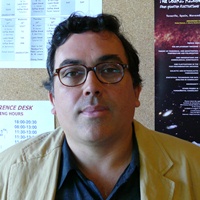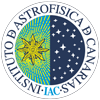Arturo Manchado Torres

Dates of the visit: 03/10/2013 to 10/11/2013.![]()
Research line: Stellar and Interstellar Physics
Institution visited: Instituto de Astronomía, Universidad Nacional Autónoma de Mexico (UNAM) - Ensenada (Mexico).
Dr. Manchado collaborated with Dr. Guillermo García Segura at the IA-UNAM on magneto-hydrodynamic (MHD) simulations on the formation of shells around post-AGB stars and PNe. The results have been published in The Astrophysical Journal.
Currently Dr. Manchado is a staff researcher at the IAC.
His main research interests are the physical processes occurring in stars reaching the final stages of their lives. When the star deplete the hydrogen as fuel it starts burning helium in its envelope and the CNO cycle is activated at its core. At this time the star ascends the Asymptotic Giant Branch (AGB). This evolutionary phase may last about a million years. At the end of the AGB, due to the thermal pulses the star can lose 80% of their mass. When mass loss ceases, the envelope expands and increases its temperature, starting to ionize the circumstellar gas. This phase is called post-AGB. Later the temperature of the star continues to rise until its temperature reaches 30,000 K, and the hydrogen in completely photo-ionized , then begins the planetary nebula phase (PN). Since the post-AGB phase is very short, between 1000 and 10000 years, it is very little known.
During the last 30 years, the study of the morphologies of the PNs, has provided valuable information about their formation mechanisms. However processes that give rise to the different morphologies observed on PNs, are not known in detail.
During his stay at Institute of Astronomy at UNAM-Ensenada (Mexico), Dr. Manchado worked with Dr. Guillermo García-Segura (one of the world's most renowned researchers in the field of hydrodynamic simulations), carrying out magneto-hydrodynamic (MHD) simulations on the formation of shells around post-AGB stars and PNe, both for single stars with rotation and for stars with planets.
They calculated new stellar evolution models including the effects of rotation and magnetic pairs under different assumptions. The objective was to test whether a single star could sustain the rotation speed necessary to generate a bipolar planetary nebula (PN), when high rates of mass loss are considered. Magnetohydrodynamic simulations of intermediate-mass stars (2.5 and 5 solar masses) were carried out, which showed that a single rotating star could not form a bipolar planetary nebula.
This result has been published in The Astrophysical Journal (García-Segura, G., Villaver, E., Langer, N., Yoon, S.-C., & Manchado, A. 2014).


